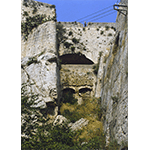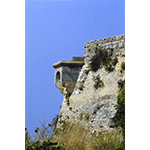Aqueduct of Castiglione della Pescaia
The problems of water supply for Castiglione della Pescaia, especially in the summer period, constituted an age-old issue that it was attempted to solve many times. The situation grew more serious after 1758, following the construction of the salterns on Castiglione territory. In 1768, after conducting a survey, the Jesuit Leonardo Ximenes assigned the works to the Carlo Ferrari company of Lugano in Mugello.
The project provided for the construction of an immured conduit, approximately 60 centimetres wide and 7 kilometres long, outfitted with pilasters, arches, bridges and air vents. In addition to the water intake at the Fonte del Fico spring, five intermediate tanks and the construction of settling tanks were planned. Terracotta piping was to be placed inside the conduit. The course began at the Fonte del Fico spring, continued along the trench of the homonymous valley, immersed in the woods known as "Conduits" woods and, after crossing the San Guglielmo brook with a bridge in the locality of Archi and supplying the water trough of Santa Maria, finally reached Castiglione.
Works went on so long that in 1773, when the conduit had reached the vicinity of Santa Maria, the first contrasts began between the community and Ximenes. With the support of the Canals Office of Grosseto, the inhabitants of Castiglione della Pescaia wanted the water to pass in front of the old salt warehouse; Ximenes instead succeeded in conveying it towards the port and the warehouse of San Francesco, so as to obtain a greater inclination. In 1781, the aqueduct was already in bad repair due to neglect and damage provoked by people who broke the piping to irrigate fields. In 1788, it was restored by engineer Salvetti who made several modifications, including the construction of a lodge perpendicular to the conduit for the control of waters and adequate ventilation. Also on this occasion, a plumber was instructed with the maintenance. The work proved such a masterpiece of hydraulic engineering that after the replacement of piping in 1816, it continued to function at length, and part of its architectural structure can still be admired today.
****************************
Texts by Graziano Magrini
English translation by Victor Beard
Last update 12/mar/2008





